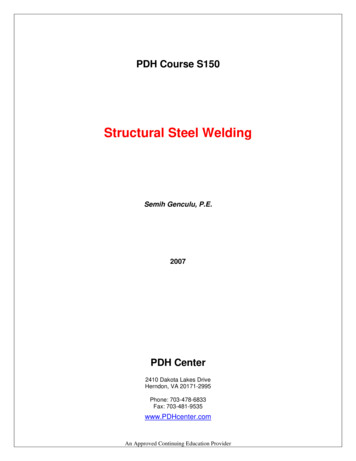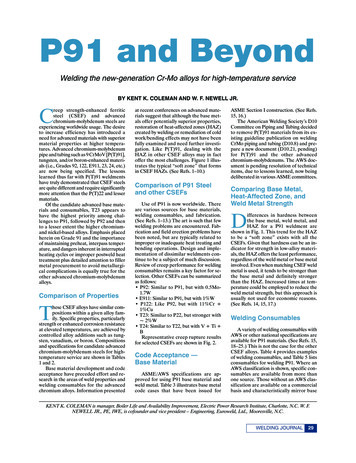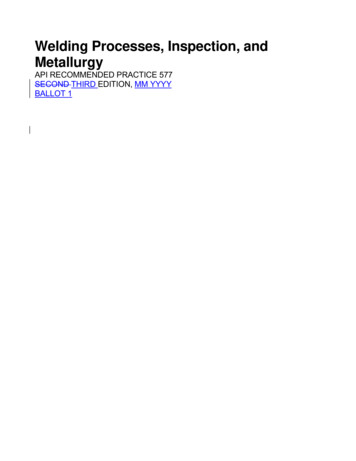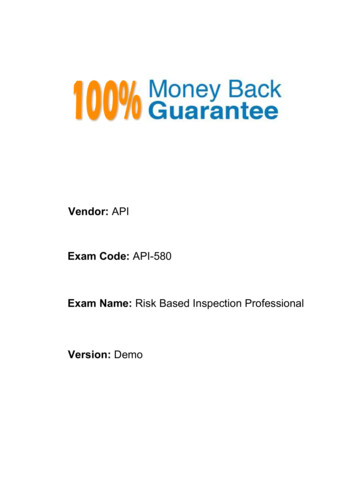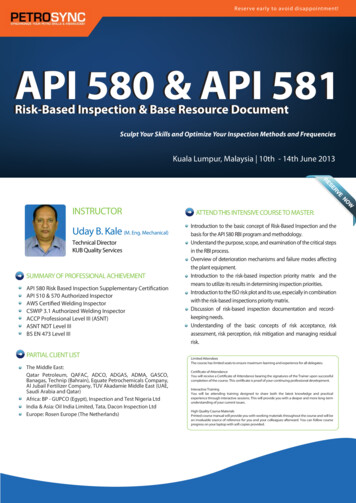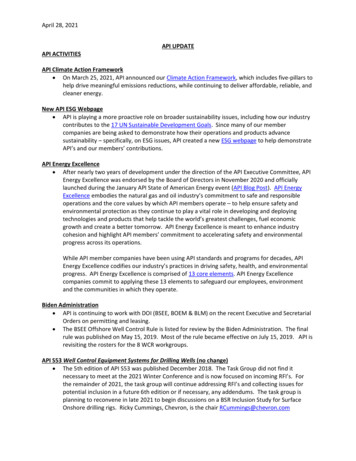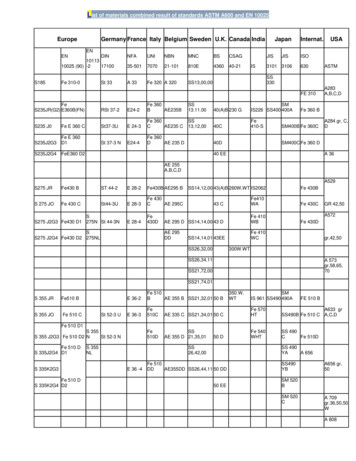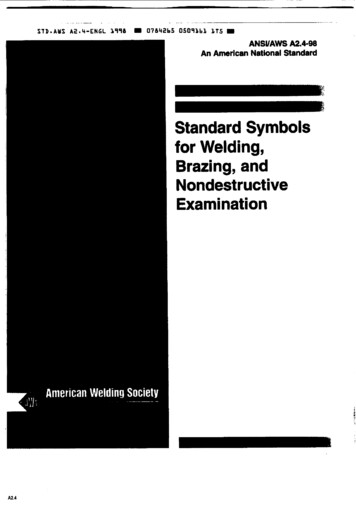
Transcription
API Standard 1104 - Welding of Pipeline and Related Facilities A3StandarEditionSectionInquiry #d18th May-9411041104-I-01-96QuestionReplyThe section on essential variables for Weld Procedure Qualifications, SectionThe groups are not specified in API-1104, they are to be selected by the user.2.4.2.5, states a change from one group to another. However, this section does notSee Para. 2.3.2.3.specify which group. Is the first group specified in Table 2 which is 12.7 mm and 12.7 mm? Or is it the group specified under Welder Qualification Tests which is 4.8mm, 4.8 mm - 19 mm, and 19 mm?110418th May-941104-I-01-96The essential variable list in Section 2.4 for Weld Procedure Qualification does notcover diameter groupings although Welder Qualification Tests do have groupings. Isit correct in saying that qualifying a procedure on 2" diameter would qualify, say, a40" diameter butt weld provided all other essential variables were met?110418th May-941104-I-01-96Welder Qualification Tests for Automatic Welding Section 9.7 does not specify anyessential variables for Welder Qualification Tests. Is this correct?110418th May-941104-I-01-96110418th May-941104-I-02-96110418th May-941104-I-02-96110418th May-941104-I-04-96110418th May-941104-I-04-96110418th May-941104-I-04-96110418th May-941104-I-04-96110418th May-941104-I-04-96110418th May-941104-I-05-96110418th May-941104Yes.Welder Qualification Tests for Automatic Welding - Since Para. 9.6 provides thatboth the equipment and the operator are qualified at the same time, the EssentialVariables specified in Para. 9.5 apply.Weld Procedure Qualification - Automatic Welding Under Section 9, this appears to Weld Procedure Qualification for Automatic Welding - The groupings are left tobe leaving the groupings of diameters and wall thickness to the Contractor as it states the writer of the procedure specification.this will be stated in the WPS. Should these groupings be per API 1104 and/orCompany requirements?Clarification of the requirements of paragraph 6.3.8.2.c with respect to clusterIf the cluster porosity cannot be proven to be in the finish pass, the criteria ofporosity is required since the collective aggregate size of porosity is being interpreted Para. 6.3.8.2 applies. If Para. 6.3.8.2c applies, then figures 18 and 19 must bedifferently by different inspectors.used even if the indication on the radiograph has been defined as clusterporosity.With similar size porosity all falling into the medium category, the density which is in If the size of the porosity is the size shown in the "medium" charts of Figures 18the assorted chart cannot be defined. When a cluster of 5 to 7 pores cannot fit intoand 19, then that is the chart which must be used as the acceptability standard.an inscribed circle on the fine chart, the client is rejecting it even though there is noother porosity within the entire radiograph. An attached sketch illustrates thecondition.If the Company has not required the use of a line-up clamp in its project specificNo. See Para. 2.3.2.11specification, does API 1104 require the use of a clamp?As paragraph 4.3 is concerning butt welds, is this indicating that a clamp must bePara. 4.3 requires that the use of line-up clamps must be in accordance with theused for butt welds and that the weld procedure specification (as discussed inprocedure specification. If the procedure specification does not require a line-up2.3.2.11) for butt welds must reflect this?clamp, then none needs to be used when making the production weld. See Para.2.3.2.11.Why is a clamp required for a weld procedure qualification, when the pipe nipples for A line-up clamp is not required for the weld procedure qualification. See Para.the WPS will have been cut from the same length of pipe and hence the dimension fit 2.3.2.11.up will be very good; whereas, the field fit ups are from pipes that will vary indimension, ovality, etc.?Regardless of what the form of words that API 1104 uses, what was the intention of We cannot comment on the intention of the committee, only what is written.the committee in regard to the use of clamp for butt weld joints?API 1104 only discusses the clamp as a method of weld alignment. If API 1104API 1104 does not discuss specific types of line-up clamps, only the method, i.e.permits the use of other methods of alignment, why are they not discussed andinternal, external or no clamp.parameters given for their use, removal, etc.? If other methods are permitted, whatare they and what other parameters govern their use?If a tensile strength is conducted for welder qualification, what information should berecorded regarding the test? Currently, (a) I measure the specimen before testing,document that, (b) calculate the specimen’s area, document that, (c) test thespecimen documenting the load, and (d) calculate the tensile strength of thespecimen, documenting the computed tensile strength. If it meets the requiredspecified minimum tensile strength of the material, it is accepted. But this is not arequirement of welder qualification is it? It appears to me, that all that is required forwelder qualification is for the tensile specimen to break outside the weld zone or meetnick-break requirements if it does break in the weld zone, and the documentation isaccepted or rejected and nothing else. Is this correct?Paragraph 3.5.3 requires that the soundness requirements of Paragraph 2.6.3.3be met. The tensile strength need not be calculated. It is therefore not necessaryto measure the tensile specimen or to record the breaking load. Only the resultsof the examination per Paragraph 2.6.3.3 need to be recorded. Paragraph 3.5.3requires that the soundness requirements of Paragraph 2.6.3.3 be met. Thetensile strength need not be calculated. It is therefore not necessary to measurethe tensile specimen or to record the breaking load. Only the results of theexamination per Paragraph 2.6.3.3 need to be recorded.1104-I-0810-961) Do a procedure and welder qualification on a butt weld, according to API 1104,qualify for unlimited fillet welds as it does with other codes such as ASME XI.1) PROCEDURE QUALIFICATION One of the essential variables listed inParagraph 2.4 is 2.4.2.3 "Joint Design." Here it states that a major change injoint design constitutes an essential variable. A change from a butt to a fillet weldis a major change in joint design, thus requiring that a new procedure bequalified. WELDER QUALIFICATION If a welder qualifies by making a buttweld per Paragraph 3.2 "Single Qualification," that welder is subject to theessential variables listed in 3.3.2. Here in subparagraph "g," it states that achange in joint design constitutes an essential variable. A change from a butt toa fillet weld is a major change in joint design. That welder would therefore, not bequalified to make fillet welds. (2) Paragraph 4.3 requires that the use of line-upclamps must be in accordance with the procedure specification. If the procedurespecification does not require a line-up clamp then none needs to be used whenmaking the production weld. See Paragraph 2.3.2.11.(3) A line-up clamp is notrequired for the weld procedure qualification.See Paragraph 2.3.2.11. (4) We cannot give advice on the use of clamps, onlyinterpretwhat is written. (5) API 1104 does not discuss specific types of line-up clamps,only themethod, i.e., internal, external, or no clamp. This covers every possible method.18th May-941104-I-0913-96The API-1104 Standard does not require charpy testing. Therefore, we cannotrespond to your question.110418th May-941104-I-1015-96On samples extracted such that their length is parallel to the pipe axis, are shearvalues required from testing? Is pipe mill roll direction relevant to the testing of siteproduced vertical butt welds?Four examples of repair situations that could arise are attached. They are labeledExamples 1, 2, 3, and 4 and are only scenarios and are not actual cases that haveoccurred on any project. Please review the four examples. In each example, is therepair acceptable in accordance with sections 6 and 7 of API Standard 1104?110418th May-941104-I-1015-96What is the definition of the words "injurious Defect" as they are used in paragraph7.1.2, Removal and Preparation For Repair, API Standard 1104, 18th - May 1994?Any defect that exceeds the standards of acceptability.110418th May-941104-I-1015-96What is the definition of the words "Sound Metal" as they are used in paragraph7.1.2, Removal and Preparation For Repair, API Standard 1104, 18th - May 1994?Sound metal, as used in Paragraph 7.1.2, is the metal that remains after theinjurious defect has been removed.110418th May-941104-I-1019-96Paragraph 2.6.3.2 states that nick-break samples shall be broken by: ) pulling in atensile machineb) supporting at each end and striking the middle;c) supporting one end and striking the other end. Is it the intent of the code tospecifically rule out other methods of causing fracturing through the weldment?Paragraph 2.6.3.2 provides only three methods of breaking a nick break couponso that it is all that can be used . However, your point is very understandable sowe are sending your letter to the Welding Procedures and Welder Qualificationssubcommittee for review and possible revision to the standard.110418th May-941104-I-1122-96Can I use a fillet weld procedure qualified using a non-bevel lap fillet to complete a 45 Paragraph 2.4.2.3 "Joint Design" specifies that a major change in joint designdegree single bevel fillet weld? And, vice versa.constitutes an essential variable thus requiring requalification. A change from anon-bevel lap fillet weld to a bevel fillet weld is a major change as it involves abevel in addition to the fillet. However, if the same procedure is qualified on abevel fillet weld, the same procedure can be used to weld a lap fillet because inthe qualified procedure, once the bevel is filled, the joint design remaining isessentially the same as that of a lap joint.110418th May-941104-I-1122-96When qualifying welding procedures for fillet welds, one must note the range of wallthickness and diameters over which the procedure is applicable. Is API 1104referring to the wall thickness and diameter of the branch or header piping?Both.110418th May-941104-I-0130-97Under Section 3.2.2 and 3.3.2 for multiple qualification of welders, is it correct inunderstanding that a welder who has successfully completed the multiplequalification tests using filler metal from the group 1, (example E-6010& E-7010), inthe downhill travel progression would also be required to successfully complete thosesame two tests using filler metal from the group 3, (E-7018), in the uphill traveltechnique to install attachment fittings on pipelines such as thread-o-lets, requiringthe use of E-7018, since the weld joint for fittings is a full penetration single bevel?Yes. Paragraph 3.3.2.b requires requalification. if the direction of weldingchanges from vertical uphill to vertical downhill or vice versa. Also, paragraph3.3.2.c requires requalification. if the filler metal classification is changed fromGroup 1 or 2 to Group 3 or from Group 3 to Group 1 or 2.110418th May-941104-I-0130-97No. The welder could be qualified under 3.2 "Single Qualification."110418th May-941104-I-0130-97After completion of the multiple qualification tests prescribed in section 3.3.2 using E6010 and/or E-7010 electrodes in the downhill progression, and electing not to certifyon a full size branch test again, is the only other option for a welder to be qualified forwelding fittings on a pipeline using E-6010 for the root and E-7018 for the fill andcover passes are those outlined in ASME Section Ix, Boiler & Pressure Vessel Code,QW 452?Question 3 refers to API RP 1107, Third Edition April 1991. Section 3.1 allows for awelder to perform maintenance welding after successfully completing therequirements of API Std 1104 3.1 to 3.6 or API RP 1107 3.2 to 3.5. Is a welderqualified to install sleeves using E-7018 if the welder test on a Butt and Branch usingE-7018?Example 1 Yes. Example 2 Yes, assuming that "Clause 6.3.2.a" in the firstsentence was intended to be 6.3.8.2. Example 3 Yes. Example 4 Dependsupon the diameter of the pipe. See paragraphs 6.3.4.c and 6.3.7.2.g.We assume that by "---on a butt and branch---" you mean the butt weld andbranch described in paragraph 3.3.1 of API 1104 and to the branch described inparagraph 3.2 of API 1107. With this assumption the answer to your question isyes. However, to install sleeves the welder does not need to make a butt weldqualification test. The welder can make a single qualification test as described inthe second paragraph of 3.2.1 of ASPI 1104.
110418th May-941104-I-0130-97Questions 4 & 5 refer to API 1104, 18th - May 1994 and API RP 1107, Third Edition, Yes but the welder would only be qualified to weld using Group 1 or 2 electrodesApril 1991.Provided a procedure was qualified and a welder was tested on the 12downhill on the root pass and Group 3 electrodes uphill on the fill and cap3/4" dia. butt weld and a 12-3/4 dia. full size branch test, per API Std. 1104 Sec. 3.3, passes.using E-6010 downhill for the root passes and E-7018 uphill for the fill and coverpasses, wouldn’t this welder meet the criteria as outlined in API Std. 1104, Sec. 3.3.2for qualifications to weld in all positions, all wall thickness', joint designs, and fittingson all pipe diameters, including the installation of full encirclement sleeves as outlinedin API RP 1107, Sec. 3.1?110418th May-941104-I-0130-97DOT CFR 192, Sec. 192.229(C) states that welders are required to re-certify after 6 The subject of a time limit for the qualification of welders has always been left tomonths unless proof of welding using the process for which they are certified under is the codes and user companies. However, this subject will be presented to theproduced. DOT 195, Sec. 195.222 does not address a specific qualification termAPI 1104 Subcommittee On Welder Qualification for review.limit. Both
API 1104 does not discuss specific types of line-up clamps, only the method, i.e. internal, external or no clamp. 1104 18th May-94 1104-I-05-96 If a tensile strength is conducted for welder qualification, what information should be recorded regarding the test? Currently, (a) I measure the specimen before testing, document that, (b) calculate the specimen’s area, document that, (c) test the .
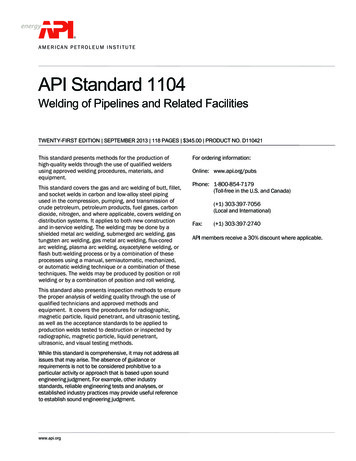
![API Ballot: [Ballot ID] – API 510 & API 570, Deferrals, Rev05](/img/5/api510andapi570deferralsrev5.jpg)
